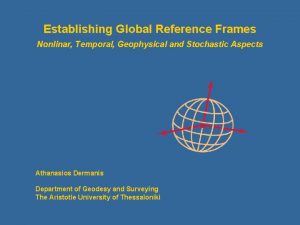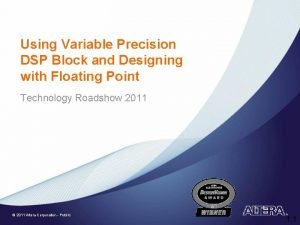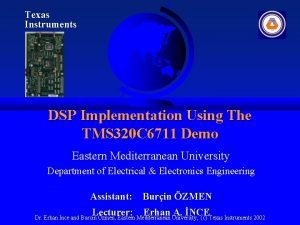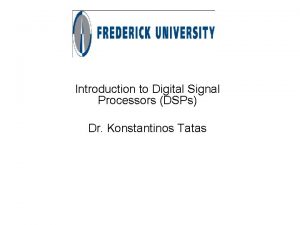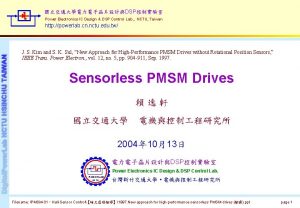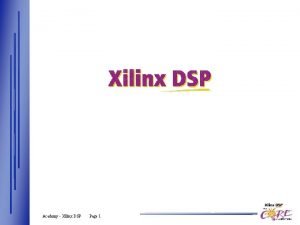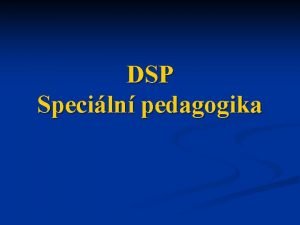2006 DSP Test 2 Reference Solution Solution xn

![• Solution: x[n] y[n] Z-1 2 3 Z-2 5 • Solution: x[n] y[n] Z-1 2 3 Z-2 5](https://slidetodoc.com/presentation_image/1c6d3ed4f4d7c79ee187ce6c93889e13/image-2.jpg)

![• Solution (a) E 0(z) = h[0] + h[3]z-1 + h[6]z-1 E 1(z) • Solution (a) E 0(z) = h[0] + h[3]z-1 + h[6]z-1 E 1(z)](https://slidetodoc.com/presentation_image/1c6d3ed4f4d7c79ee187ce6c93889e13/image-4.jpg)
![• Solution: Observation 1: The goal of the system is to sample y[n] • Solution: Observation 1: The goal of the system is to sample y[n]](https://slidetodoc.com/presentation_image/1c6d3ed4f4d7c79ee187ce6c93889e13/image-5.jpg)
![• Solution (cont. ) x[n] Z 0 (z 3) x[n] ↓ 3 z-1 • Solution (cont. ) x[n] Z 0 (z 3) x[n] ↓ 3 z-1](https://slidetodoc.com/presentation_image/1c6d3ed4f4d7c79ee187ce6c93889e13/image-6.jpg)




- Slides: 10

2006 DSP Test 2 - Reference Solution -
![Solution xn yn Z1 2 3 Z2 5 • Solution: x[n] y[n] Z-1 2 3 Z-2 5](https://slidetodoc.com/presentation_image/1c6d3ed4f4d7c79ee187ce6c93889e13/image-2.jpg)
• Solution: x[n] y[n] Z-1 2 3 Z-2 5

• Solution: zeros 1. 5 ej(0. 6π) 1. 5 e-j(0. 6π) reciprocals & the conjugates 2/3 ej(0. 6π) 2/3 e-j(0. 6π) 2/3 ej(0. 6π) The all-pass component: The minimum-phase component: Therefore, H(z) can be expressed as H(z) = Hmin(z)Hap(z).
![Solution a E 0z h0 h3z1 h6z1 E 1z • Solution (a) E 0(z) = h[0] + h[3]z-1 + h[6]z-1 E 1(z)](https://slidetodoc.com/presentation_image/1c6d3ed4f4d7c79ee187ce6c93889e13/image-4.jpg)
• Solution (a) E 0(z) = h[0] + h[3]z-1 + h[6]z-1 E 1(z) = h[1] + h[4]z-1 + h[7]z-1 E 2(z) = h[2] + h[5]z-1 + h[8]z-1
![Solution Observation 1 The goal of the system is to sample yn • Solution: Observation 1: The goal of the system is to sample y[n]](https://slidetodoc.com/presentation_image/1c6d3ed4f4d7c79ee187ce6c93889e13/image-5.jpg)
• Solution: Observation 1: The goal of the system is to sample y[n] every 3 data points. – Apply H(z) only on the 1/3 signal portions will effectively reduce the needed computational operations. Observation 2: The two systems below are equivalent. x[n] H(z) ↓ 3 y[n] y’ [n] ↓ 3 H(z) w[n] w’ [n]
![Solution cont xn Z 0 z 3 xn 3 z1 • Solution (cont. ) x[n] Z 0 (z 3) x[n] ↓ 3 z-1](https://slidetodoc.com/presentation_image/1c6d3ed4f4d7c79ee187ce6c93889e13/image-6.jpg)
• Solution (cont. ) x[n] Z 0 (z 3) x[n] ↓ 3 z-1 Z 1 z-1 Z 2 (z 3) original ↓ 3 + y[n] ↓ 3 Z 0(z 3) ↓ 3 Z 1 (z 3) ↓ 3 Z 2(z 3) z-1 answer + y[n]

• Solution: Answer 3 is the most accurate statement. Since, for Decimation in Time, the figure is the basic butterfly with r = 2; for Decimation in Frequency, the figure is the end of one butterfly and the start of a second with r = 2.

• Solution: (a) A function that describes the average power of a signal. (b) A random process with a flat power spectral density. (c) An operation of combining two finite-length sequences, in which the output is obtained by circularly time reversing and circularly shifting one sequence with respect to another.

• Solution: (a) F is the Nx. N matrix with the element of k-th row and n-th column as (b) 1. According to V=FUF, it can be decomposed as the computation of 2 N 1 -D DFTs. 2. Each 1 -D DFT requires Nxlog 2 N computations. 3. So, the 2 -D DFT can be efficiently implemented in time complexity of O(N 2 xlog 2 N)

• Solution:


